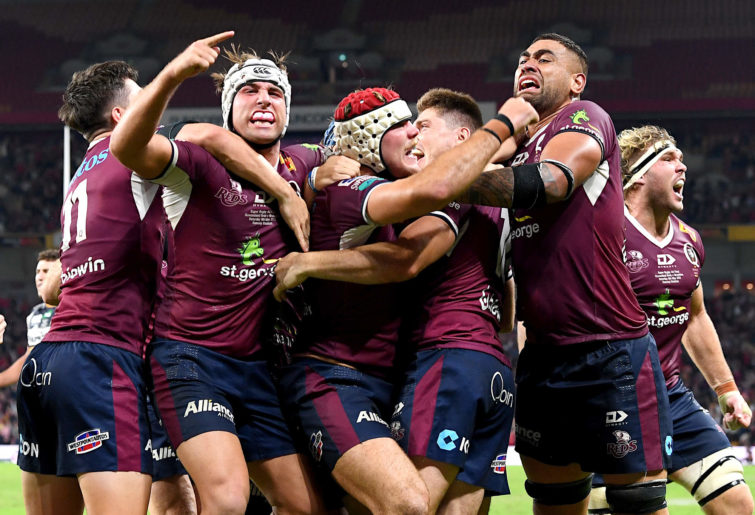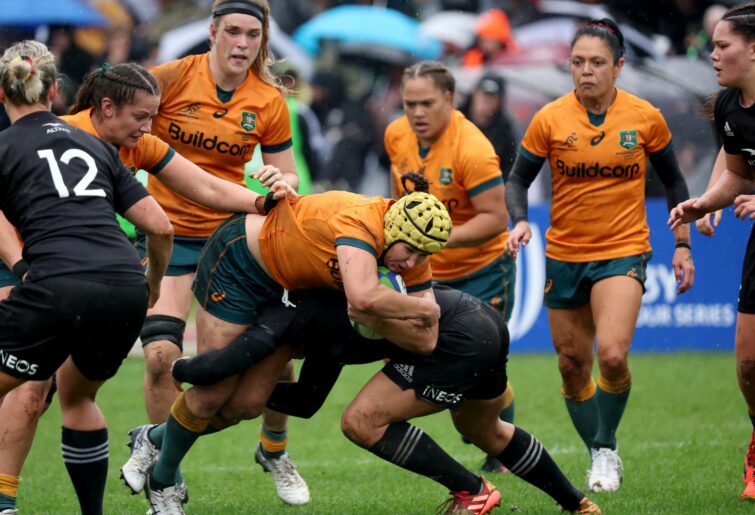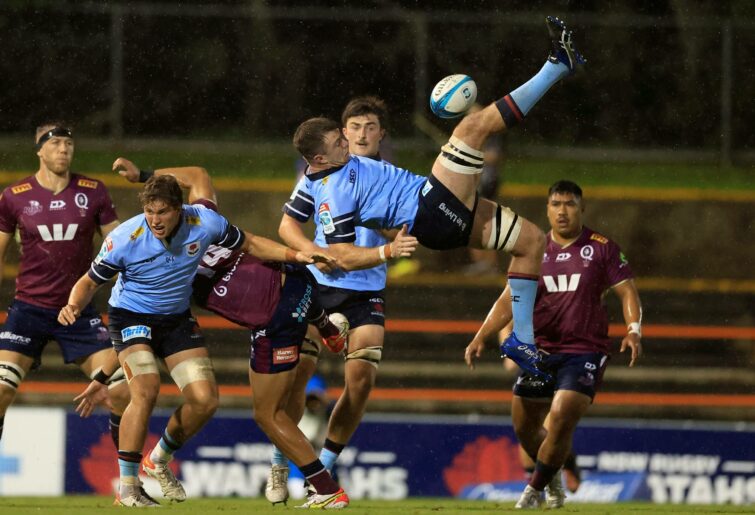In 1983 Australia famously won yachting’s America’s Cup. Following in the wake of John Bertrand and his crew, accomplished sailors like Jimmy Spithill, Adam Beashel and Glen Ashby later emerged to skipper, crew and win the Auld Mug.
Notably, their America’s Cup success came on overseas boats. Sound familiar?
Think Will Skelton winning the European Cup with La Rochelle, Scott Fardy with Leinster, and Dave Dennis the English premiership with Exeter.
Australian sailing had the talent within its ranks. It just never had the money to continue to be competitive at the elite level.
In 1995, Australia’s America’s Cup campaign foundered when ‘One Australia’ broke up and sank to the bottom of the Pacific Ocean, off San Diego. Humiliation was complete when the inevitable jokes from New Zealand rained in about the Kiwis re-designing their boat with a glass hull, to enable them to keep a close eye on the Aussies.
Australia tip-toed a very fine line, ended up pushing their boat out too far, and it sank.
Rugby Australia, embolden by confirmation of World Cup hosting rights and the resultant certainty afforded them, and frustrated by years of playing second fiddle to their trans-Tasman neighbour, is now in the throes of pushing its boat out.
Waters in this corner of the world however, are perpetually choppy. Will history judge Rugby Australia chairman Hamish McLennan the triumphant skipper of Australia II, or the man who jumped off One Australia as it went down?

Hamish McLennan. (Photo by Mark Metcalfe/Getty Images)
Trans-Tasman skirmishes are nothing new, and New Zealand’s clumsy attempt last year to re-design Super Rugby to include only two Australian franchises was a reminder that muddled thinking, insensitivity and poor communication are not the exclusive domain of any one party.
Bread was broken, and a faintly romantic stroll along Manly Beach signalled a reconciliation. Super Rugby Pasifika emerged; fresh, shiny and new, and a period of consolidation appeared to be upon us.
Why then, has McLennan opened up old wounds; without, publicly at least, provocation from the New Zealand side? And, most importantly, what are the implications?
Popularly viewed as a lever to extract a more equitable share of broadcasting dollars, there seems little harm in Australia asking that question, no matter how ham-fisted the method. And of course, there is nothing wrong with Australia continuing to reassess what is in its best interests.
But what if is McLennan is serious? What if Australia pushes the boat out so far that Super Rugby is cast adrift? Or they damage the competition and brand so much that it isn’t worth salvaging?
The proposition has been put that Australia should replace Super Rugby with a domestic competition.
In 26 years of Super Rugby, Australian franchises have won four times. In five other years, an Australian franchise was the losing finalist. That’s not a return that excites and engages local broadcasters or fans.
In one year of Super Rugby AU, Australia provided the winner and runner-up, and plenty of fans watched; either at Suncorp Stadium or at home.

(Photo by Bradley Kanaris/Getty Images)
But the premise is a misleading one; not because Super Rugby is working for Australia, or because a domestic competition isn’t desirable, but because it is the wrong answer to the wrong question.
Australia hasn’t won the Bledisloe Cup for 20 years. Does that mean the Bledisloe Cup is broken? That Australia should stop competing for it? What if Australia just got better and won the damned thing back?
Australian rugby’s conundrum is the same as it has ever been: Super Rugby or no Super Rugby, Australia hasn’t figured out how to construct a high-performance domestic rugby competition that works for everyone.
Until this piece is solved, the matter of choosing between Super Rugby or a domestic alternative is akin to mounting an America’s Cup challenge choosing between using a dinghy or a canoe. It makes no difference.
Sport is emotional and parochial. For sport to engage participants and audiences in a long-lasting way, these elements – the tribalism everyone agrees is desirable – must be forefront. People have to care, otherwise it isn’t really sport, it is recreation.
There’s a sense that, right now, emotion and parochialism are front and centre for Rugby Australia; in itself, no bad thing. But for rugby to move forward, underlying issues have to be addressed first.
Is Australian rugby’s governance and structure, with its inbuilt state/federal tensions, fit for purpose?
How does rugby solve its demographic issue, where the overwhelming concentration of players in Sydney and Brisbane conflicts with a desire for the game to have a national footprint?
Can the commercial realities ever be overcome? The size of Australia’s rugby market – that is, people prepared to give their time and money to play and watch rugby – remains small by global rugby standards, and by comparison to domestic sports such as AFL and rugby league.
One reason NRL and AFL can afford to run high-profile domestic competitions, which capture the attention of fans and broadcasters, is because those competitions (including State of Origin) are the pinnacle of their sports.
Rugby’s pinnacle is the World Cup, then Test match rugby, then below that, professional franchise/club rugby. Would a domestic competition that ranks somewhere below this, generate sufficient broadcasting revenue and fan interest?
How can non-Wallaby professional players get off the training treadmill and play more rugby? Preferably in a meaningful way that enhances cohesion through logical structures and pathways?
How does Australia compete financially to retain its elite playing talent in Australia? Or, if it can’t, how will this impact upon the Wallabies, and Australia’s standing in world rugby?
With every professional coach and player – from Dave Rennie down – wanting to test themselves against the best and enjoy the benefit that comes from developing cohesion in the high-performance program, how does that reconcile with a desire to stamp an independent, national identity all over Australian rugby?

(Photo by Ian Hitchcock/Getty Images)
Super Rugby has been identified as the cause of Australian rugby’s problems, without actual evidence to support this. What’s to say Australian rugby wouldn’t be worse without it?
Working through the touted alternatives illustrates the enormity of the challenge.
Use the existing five franchises in a domestic professional competition? Not enough content or too many repeat matches.
Add three or five teams to the existing five? That feels very much like the same NRC which Rugby Australia didn’t have the heart or the money to continue with. And who is buying the fuzzy logic of the Waratahs and Reds – ostensibly the New South Wales and Queensland state teams – competing against other teams from Sydney and Brisbane?
And what of all the many critics who claim that Australia doesn’t have the talent to support five, or even four, professional teams; what does that say about the quality of an eight or ten-team competition?
Discontinue the existing franchises and create all new teams, some of them perhaps privately owned? Tribalism, anyone? And owned by whom?
Use existing club teams? That’s the tribalism box ticked. But which clubs are anointed winners and which losers? How many clubs have the infrastructure and personnel to operate even semi-professionally? And how would a professional or semi-professional club presence sit alongside ‘regular’ club rugby?
There is a distinction between high performance professional rugby and semi-professional and club rugby that is real and can’t be wished away. Standards are set, not by Australia, but for Australia, by what happens in other professional competitions around the world.
For Australia to compete as a serious, competitive rugby nation it must match or better the levels of professionalism in other places. No better is this example illustrated than in women’s rugby.

(Photo by Andy Jackson/Getty Images)
The Wallaroos currently sit some distance behind England and France. The reason isn’t that English and French women rugby players are better; they simply play more and train more in fully professional programs.
The same argument applied in reverse when Australia won the 2016 Olympic Games sevens gold medal. Talent identification and coaching were strong, but the key difference was how professional and advanced Australia’s program was compared to the competition.
Honest conversations must be had. Rennie, and almost every professional coach, administrator and player involved with Australia’s Super Rugby franchises knows that playing standards will drop as a result of Australia tuning out.
They know this because if they can’t test themselves, and achieve their market value in Australia, they will do so elsewhere in the world.
And if the counter-argument is that the quality of the competition doesn’t matter as long as it’s ours, or it will rebuild itself to world class over time of its own accord, the kindest response is to point in the direction of football and ponder where the A-League sits on a world scale and what the Socceroos world ranking is, and ask if that’s a price Australian rugby is prepared to pay?
So, what is it that can realistically be achieved?
There are few choices. Run a domestic competition (in whatever form chosen) in the first half of the year, where Super Rugby used to be. Or stay in Super Rugby and run a domestic competition during and after the June internationals, and/or after the club season has finished.
There are tensions at all turns. Test matches, a professional competition and club rugby all running concurrently is too much. Leave it too late and you run out of weeks in which to run a meaningful competition.

Jed Holloway. (Photo by Mark Evans/Getty Images)
Perhaps one alternative might be to run with the Vikings, Rising and Spirit, along with each season’s two or three top clubs from the Shute Shield and Hospital Cup?
But that would still risk funnelling better players into a few select clubs, and ignore how the failure of the NRC points to fans largely being unwilling to support a development competition that doesn’t contain Australia’s best players.
If all roads lead back to the first half of the year, something akin to last year’s format of separate AU and Aotearoa competitions before a cross-over Pasifika round (with or without Japanese presence at the finals stage) presents as the most logical on paper; albeit all of the franchises currently preferring to blend NZ and Australian matches.
The reason a domestic solution for Australia has proved so elusive is because the problem really is that difficult.
New Zealand, France and England have a ready supply of provinces, towns and clubs, geographically spread, that have existed since rugby existed. Australia has just two large rugby provinces, a third that fights above its weight, and two others that are doing their best to keep up.
That’s simply not enough to work with. Any alternative solution either is devoid of tribalism and logic, requires too much money, or falls back into an amateur club rugby network that is ill-equipped to handle it.
There is one remaining option. Super Rugby can be made so much better than it is.
Before the good ship SS Australia drifted off its mooring last week, it was understood that the two nations were edging closer to an agreement along the lines of a semi-autonomous body, better resourced so as to allow for Super Rugby to be operated and promoted far better than in the past.
Throw in a restricted draft, or a mechanism that allows a limited number of players to play for overseas franchises while retaining eligibility for national selection, and that would be a sure-fire way to rekindle fan interest and help equalise the competition.
As difficult as it has been for Australian sides to win Super Rugby – or in recent years, even be competitive – Australia continuing to close ‘the gap’, and both nations reinvigorating and properly promoting Super Rugby feels like a far more palatable option than introducing a half-baked domestic alternative for no real reason other than to ensure a local winner. Or to stick it to the Kiwis.
Whatever Rugby Australia decides to do, one thing that must change, is that the narrative must switch to the positive. If Super Rugby as we know it is dead, tell us what the alternative is and sell its merits.
Alternatively, if Australia has no intention of walking away from Super Rugby, stop trashing it then expecting fans to embrace it again next year.
There are so many minefields for Australian Rugby to manoeuvre around already, it doesn’t need the skipper setting about scuttling his own ship.

































































































